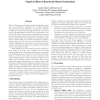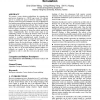158 search results - page 31 / 32 » Strong logics of first and second order |
HPCA
2005
IEEE
14 years 5 months ago
2005
IEEE
The use of large instruction windows coupled with aggressive out-oforder and prefetching capabilities has provided significant improvements in processor performance. In this paper...
SODA
2010
ACM
14 years 2 months ago
2010
ACM
Many NP-hard problems can be solved efficiently when the input is restricted to graphs of bounded tree-width or clique-width. In particular, by the celebrated result of Courcelle,...
COMPSAC
2009
IEEE
13 years 10 months ago
2009
IEEE
Given the rapid rise of model-driven software development methodologies, it is highly desirable that tools be developed to support the use of design patterns in this context. This...
ISCA
2000
IEEE
13 years 10 months ago
2000
IEEE
Smaller feature sizes, reduced voltage levels, higher transistor counts, and reduced noise margins make future generations of microprocessors increasingly prone to transient hardw...
GLVLSI
2007
IEEE
13 years 7 months ago
2007
IEEE
We present a vector selection methodology for estimating the peak power dissipation in a CMOS logic circuit. The ultimate goal is to combine the speed of RT-level simulation with ...


